Unleashing Creativity with Drone Photography and Videography
- Jordan Licon

- Oct 7
- 4 min read
When I first took to the skies with a drone, I was amazed at the new perspective it offered. Suddenly, the world below transformed into a canvas of endless possibilities. Whether you’re a hobbyist or a professional, mastering aerial visuals can elevate your creative projects to new heights. In this guide, I’ll share practical tips, insights, and recommendations to help you unlock your full potential with drone photography and videography.
Exploring the Power of Aerial Visuals: A Guide to Creativity
Aerial visuals open up a fresh way to tell stories and capture moments. Unlike traditional photography, drones allow you to explore angles and compositions that were once impossible or costly to achieve. From sweeping landscapes to intricate architectural details, the sky is no longer the limit.
Here’s why aerial visuals are a game-changer:
Unique perspectives: Capture scenes from above, revealing patterns and shapes invisible from the ground.
Dynamic storytelling: Use movement and altitude changes to add drama and flow to your videos.
Access to hard-to-reach places: Safely explore locations that are difficult or dangerous to access on foot.
Creative freedom: Experiment with light, shadow, and scale in ways that challenge conventional photography.
I recommend starting with simple flights to get comfortable with your drone’s controls. Practice smooth movements and try different altitudes to see how the scene changes. Over time, you’ll develop an eye for compositions that truly stand out.

Essential Tips for Capturing Stunning Aerial Visuals
To make the most of your drone, you need more than just good equipment. Here are some key tips that have helped me consistently capture stunning shots:
Plan your shots: Scout locations ahead of time and think about the story you want to tell. Use apps to check weather and lighting conditions.
Use manual camera settings: Adjust ISO, shutter speed, and aperture to control exposure and avoid overexposed skies or dark shadows.
Fly smoothly: Sudden movements can ruin a shot. Practice gentle, steady controls for cinematic footage.
Mind the light: Golden hour (shortly after sunrise or before sunset) offers soft, warm light that enhances colors and textures.
Experiment with angles: Don’t just shoot straight down. Try oblique angles or low altitude passes to add depth.
Respect privacy and regulations: Always follow local drone laws and avoid flying over private property without permission.
By applying these tips, you’ll find your aerial visuals becoming more polished and professional. Remember, patience and practice are key.

What is the Best Drone for Photography and Videography?
Choosing the right drone can feel overwhelming with so many options on the market. Here’s what I look for when selecting a drone for aerial visuals:
Camera quality: Look for drones with at least 4K video capability and a high-resolution sensor for sharp images.
Stability and gimbal: A 3-axis gimbal stabilizes the camera, ensuring smooth footage even in windy conditions.
Flight time: Longer battery life means more shooting time. Aim for drones with at least 20-30 minutes per flight.
Ease of use: Beginner-friendly controls and intelligent flight modes help you focus on creativity rather than technical challenges.
Portability: Compact and foldable drones are easier to carry for outdoor shoots.
Some popular models that balance these features well include the DJI Air 2S, DJI Mavic 3, and Autel EVO Lite+. These drones offer excellent image quality and reliable performance without breaking the bank.
Before buying, consider your specific needs and budget. Renting a drone for a test flight can also be a smart way to find the perfect fit.

How to Edit Your Aerial Photos and Videos Like a Pro
Capturing great footage is just the first step. Editing transforms raw clips into compelling stories. Here’s how I approach post-production for aerial visuals:
Organize your files: Sort your photos and videos by location, date, or project to streamline your workflow.
Color correction: Adjust exposure, contrast, and white balance to enhance natural colors and fix any lighting issues.
Color grading: Apply creative color tones to set the mood—warm tones for sunsets, cool tones for urban scenes.
Stabilize footage: Use software tools to smooth out any remaining jitters.
Add music and sound effects: Complement your visuals with audio that matches the pace and emotion.
Keep it concise: Trim clips to maintain viewer interest and highlight the best moments.
Popular editing software includes Adobe Lightroom and Photoshop for photos, and Adobe Premiere Pro or Final Cut Pro for videos. If you’re new to editing, free tools like DaVinci Resolve offer powerful features without cost.
Editing is where your vision truly comes to life. Don’t rush it—take time to experiment and refine your style.
Taking Your Creativity Further with Drone Photography and Videography
Once you’ve mastered the basics, the sky’s the limit. I encourage you to push boundaries and explore new creative ideas. Here are some ways to keep growing:
Try different genres: From real estate and events to nature and abstract art, drones can capture it all.
Collaborate with others: Work with filmmakers, artists, or businesses to expand your portfolio and skills.
Join communities: Online forums and local clubs offer support, inspiration, and opportunities to learn.
Stay updated: Drone technology evolves quickly. Keep an eye on new features and software updates.
Practice safety: Always prioritize safe flying to protect yourself, others, and your equipment.
By embracing these practices, you’ll not only improve your craft but also enjoy the journey of creative discovery.
I hope this aerial visuals guide inspires you to take your drone photography and videography to new heights. Remember, every flight is a chance to see the world differently and tell your unique story from above. Happy flying!



Comments